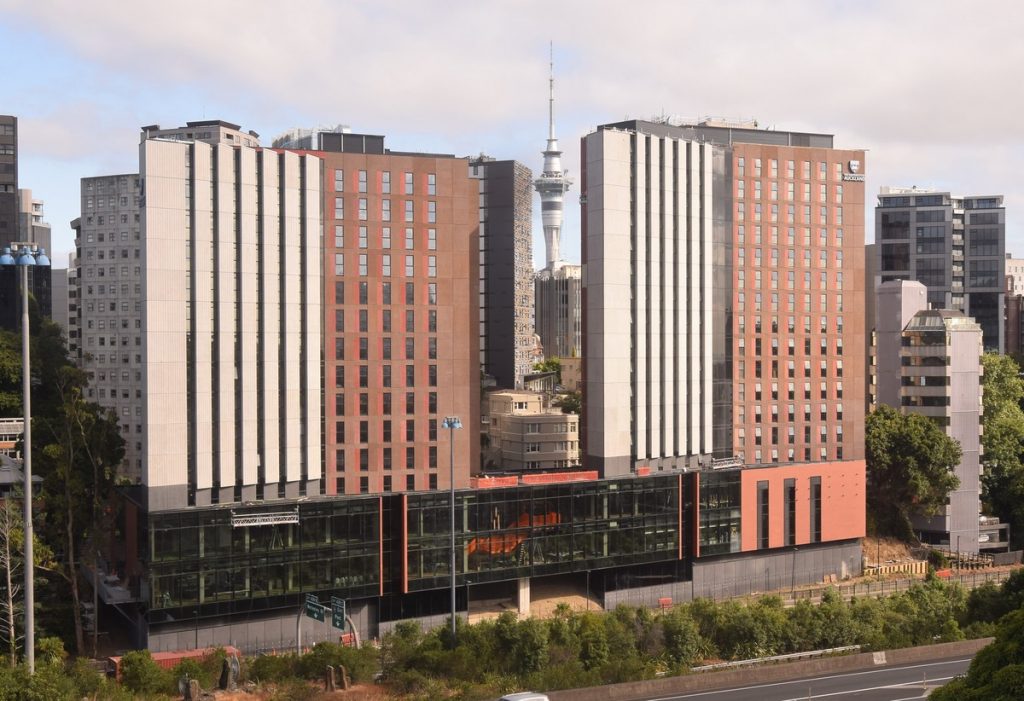The New Zealand Institute of Building (NZIOB) has announced the winners of the 2020 New Zealand Building Industry Awards, with the University of Auckland’s new Waiparuru Hall taking out the GIB® Supreme Award

The New Zealand Building Industry Awards celebrate and recognise an individuals’ professional excellence in the building and construction process of a recently completed project. This year the awards received a record number of entries.
NZIOB Chief Executive Malcolm Fleming says there are three key takeaways from reviewing this year’s entries:
- Building Information Modelling (BIM) has become a standard tool for designing and delivering commercial construction projects.
- There is no shortage of creativity being applied on our country’s building sites.
- The construction industry provides incredible opportunities for our young people. This year’s Young Achiever and our Supreme Award winner, at under 30 and 35 years of age respectively, are both responsible for delivering $100M + construction projects.
GIB® Supreme Award
The GIB® Supreme Award was, this year, won by James Reed from Dominion Constructors for managing the University of Auckland’s new Waiparuru Hall, a hall of residence for school leavers with 786 bedrooms.

The project provided numerous challenges over the 36-month build – design, logistics and programme being key concerns. Housing 786 school leaver’s from around the country meant there was no flexibility on the opening date. The site meant delivery management was a key component. Deliveries had to be done just-in-time as there was no standby on the street. James pushed for prefab toilet pods, an innovative approach that improved quality, but which required careful planning, given the lack of storage space on-site.
The Judges noted that this project started as a hard tender then converted to an Early Contractor Involvement (ECI). James embraced technology, using BIM and other new technologies where possible to simplify and enhance the build process.
They said, James was an integral part of the research behind the builder-led proposal to supply the bathrooms as modular toilet pods, as opposed to a traditional bathroom fit-out method as originally designed, as he was with the proposal to change the foundation work to a raft design. Both proposals were accepted by the client, who saw James as the main factor in delivering an exceptional result. James demonstrated excellent leadership skills, promoting innovative solutions and utilising an array of technologies that enhanced the project delivery.
BCITO Young Achievers Award
This year the judges awarded the BCITO Young Achievers Award to Rhys McKenzie from Hawkins.
Rhys began in construction working as a labourer on the Northland Region Corrections Facility (NRCF) project for Arrow. He impressed his manager, who encouraged him to undertake a construction cadetship.
On finishing his cadetship, he completed a Diploma in Construction Management at Unitec and was a finalist in the NZIOB Awards for managing the Auckland Prison Exercise Yard Modifications project. He was made Construction Project Manager at 24 years of age, returning to Northland to run a $27m NRCF project.
Rhys has subsequently delivered several Corrections projects, leading site teams on complex projects, and now runs a $100m+ project for Hawkins.
The Judges noted Rhys’ enthusiasm, attention to detail, willingness to work hard and take advantage of opportunities offered. They said he has the qualities necessary to build on the success he has achieved to date in the future and is an exceptional candidate for the Young Achiever Award.
Cost-band Awards
This year the Judges identified a Category Winner for each of the Cost-band Awards, the winners of these Awards are:
- Resene: Projects under $5M Award
Excellence & Category Winner: Kane Blank, Aspec Construction Limited
Project: St Peter’s Chapel, Auckland
- NZIOB Charitable Trust: Projects $5M-$10 Award
Highly Commended & Category Winner: Nigel Bannan, Cook Brothers Construction
Project: Dark Sky Project, Takapō (Tekapo)
- Steel Construction NZ: Projects $10M-$20M Award
Excellence & Category Winner: Craig Harris, Naylor Love Canterbury
Project: New World Durham Street, Christchurch
- Carters: Projects $20M-$35M Award
Excellence & Category Winner: James Sutherland, CMP Construction
Project: Life Apartments, 42 Liverpool Street, Auckland
- GIB®: Projects $35M-$100M Award
Excellence & Category Winner: Carl Bohnen, Naylor Love Wellington
Project: Wellington Girls’ East College Major Redevelopment, Wellington
- BBD: Projects over $100M Award
Excellence & Category Winner: James Reed, Dominion Constructors Ltd
Project: University of Auckland, Waiparuru Hall, Auckland
James Hardie Innovation Award
The James Hardie Innovation Award, recognising innovation in the industry demonstrated within a project or through an innovative new product or procedure, was won by Baran Balaban from Spiral Drillers Civil Limited.
Spiral Drillers ‘Team Workshop’ develops project-specific construction tools and equipment by using an innovative problem-solving approach. ‘Team Workshop’ is a group of Spiral Drillers Civil employees from different backgrounds including operators, engineers, mechanics and managers.
While each innovation is different, the aim is the same, to substitute labour-intensive work with speciality innovations and equipment.
Each innovation helps improve safety, productivity and quality of the specific task. When ‘Team Workshop’ is confronted with an on-site obstacle, it responds by designing and constructing specialised equipment to do the job.
The Judges noted that these innovations produced measurable production savings and improved health and safety results by removing difficult manual tasks. These innovations reduce hazards and save time and money, resulting in a ‘win-win’ for all the stakeholders on the job.
Dahua Technology Consultants Award
The Dahua Technology Consultants Award was this year, awarded to Kelly Haora from Griffiths & Associates Ltd for the Otangarie Papakainga Project in Whangarei. This award recognises outstanding performance of design consultants (architects, engineers, quantity surveyors or project managers) who have contributed to the design, documentation and delivery stages of a successful project.
The Otangarie Papakainga project was undertaken for a local Māori social services trust and involved providing up to six two-bedroomed units to provide transitional housing for whanau in need. This project was the first of its type in Tai Tokerau Tokerau and Otangarie Papakainga are planning to undertake more of these projects over the next 12-18 months.
The project’s scope included working with the client and funders, the preparation of business plans, timelines, cash flows and risk. Following the approval of the business case, Griffiths & Associates were engaged as Project Managers and Quantity Surveyors reporting to the client’s Chief Executive. The project sought a design proposal that followed traditional Maori village design principles, being considerations that saw the Resource Consent and Building Consent applications sitting well outside what are deemed to be permitted activities. These aspects along with the requirement to amalgamate two adjoining sites were elements that a typical project manager would not be required to deal with; rather, they would be given to a separate consultant to work through.
Additional challenges involved site security in an area that was accessible to the general public and difficult to secure and having to work within a tight budget with funders who expected work to be completed to an exacting standard.
Project Manager Kelly Haora overcame the challenges. He also undertook a comprehensive and long-running process of engagement with the Northland District Council, the result of which is the Council provided the necessary consents for Otangarei Papakainga. Even more impressively, this created opportunities for other Iwi projects to seek consents for projects with similar design principles in Northland. Kelly’s determination was the key to achieving an excellent outcome for his client.
Hays Interdisciplinary Collaboration Award
The Hays Interdisciplinary Collaboration Award, recognising exceptional examples of collaborative partnerships between consultants and contractor, was won by Neville McAnnalley, Leighs Construction; Neville Clarke, WSP Opus; James Bones, Beca; Patrick Dowle, Department of Corrections; and Brett Zeiler, White Construction for the Mt Eden Corrections Facility (MECF), Auckland.
This project formed part of the Department of Correction’s ‘Capacity Programme’ within the largest remand prison in the country. MECF has a high volume of prisoner movements, releases and visits.
The 7,770m2 multi-storey accommodation block is in the middle of the MECF and accommodates 245 prisoners. Building a team capable of delivering a project of this scale and complexity was always going to be challenging. Taking a historic design, changing the delivery architect and going on to construct the works provided additional challenges.
The Judges said that the Department of Corrections was committed to collaboration, creating a site office for the client representative, consultants, and contractor to co-habit during the construction of the project. This collaboration helped ensure a well-executed project.
Site Safety & CHASNZ Safety Excellent Award
The Site Safety & CHASNZ Safety Excellent Award, which celebrates a new product or process that promotes construction safety, was this year awarded to Teck Khing Yong and Daniel Chang Liu of Livefirm Construction (North Island) Limited for their Livefirm Mitre Saw Dust Control Station.
The Livefirm Mitre Saw Dust Control Station addresses dust extraction by collecting more than 90 per cent of dust produced. As a result, it significantly reduces the dust inhalation hazard, thereby providing significant health benefits. Teck Khing Yong and Daniel Chang Liu have designed an innovative, mobile, cyclone and bucket system that uses a cyclone effect to trap dust. While the primary benefit is reducing dust inhalation, it also reduces cleaning time and maintenance costs. Other advantages include reduced energy consumption.
The Judges said this innovation provides multiple health and safety benefits, resulting in an enhanced working environment.



